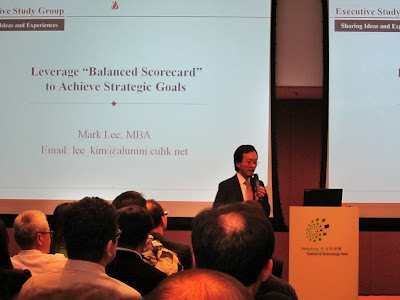Mr. Mark Lee was the speaker and his talk was included “Fundamental of a Strategy”, “Balanced Scorecard”, “Why Strategy Maps”, “Its Application & Pitfall” and “Group Discussion”.

Mr. Mark Lee introduced Prof. Michael Porter's three strategy. (Professor was combined Michael Jackson and Harry Porter - Just joking)
l Defining Unique Position
l Making Trade-offs
l Forging Fit Among Activities (環環緊扣)
Then he used IKEA as an example.

Then Mr. Mark Lee briefed Roberts S. Kaplan and David P. Norton's Balanced Scorecard. Its performance measurement included:
l Financial
l Customer
l Internal process
l Learning and growth
Company assets separated into tangible and intangible. Intangible assets measurement usually reflected the long-term value and help to set the strategy.

He used Apple Computer as case study. Apple Computer employed Balanced Scorecard as follows:
l Customer Perspectives - Customer satisfaction and Market share
l Internal Process Perspectives - Core competence (e.g. User-friendly interfaces)
l Learning and Growth Perspectives - Employee attitudes (e.g. Understand company's strategy)
l Financial Perspectives - Shareholder value
He added the platform for communication was very important.

Mr. Mark Lee shared his strategy map which combined Michael Porter's strategy and Balanced Scorecard. It started from Customer Perspectives to Financial Perspectives. The values of strategy maps were a clear line of sight into how their jobs were linked to the overall objectives of the organization and enable staff to work in a coordinated, collaborative fashion toward the company's desired goals.

The 1st Step was Customer Perspective (Defining a company's unique position).

Customer Intimacy Strategy of Mobil was briefed.

The 2nd Step was Internal Process Perspectives.

Measurement of internal process was combined with the strategy of "Forging Fit Among Activities".
The 3rd Step was Learning and Growth Perspectives. IT would play an important role.

The 4th Step was Financial Perspectives. The following diagram compared the financial measures against non-financial measures.
Mr. Mark Lee said using strategy map could found out the gap and took an improvement.
Lastly, he concluded using strategy map with Balanced Scorecard elements was able to fine-tune the strategy.
After that talk, we had an exercise to find out one easiest and two difficult challenge for strategy design and execution.
Reference:
The Centre for Logistics Technologies and Supply Chain Optimization, CUHK: http://www.logitsco.cuhk.edu.hk/
HKSTP - www.hkstp.org






沒有留言:
發佈留言